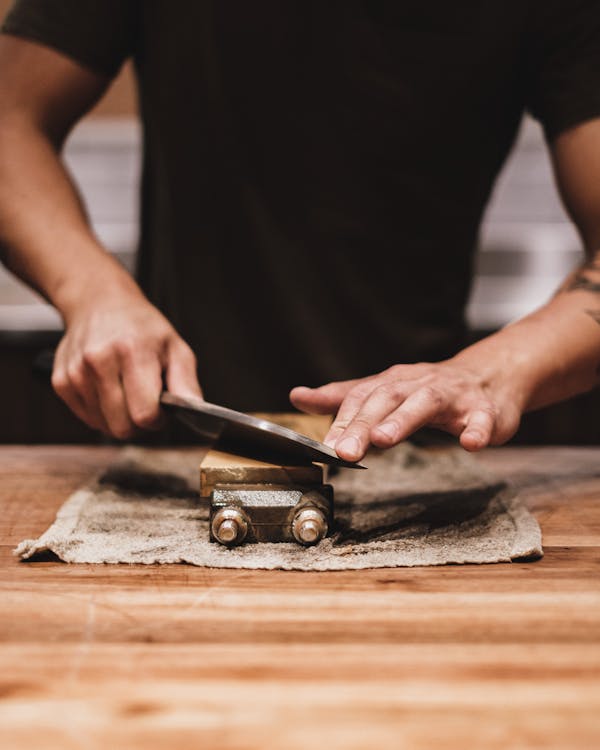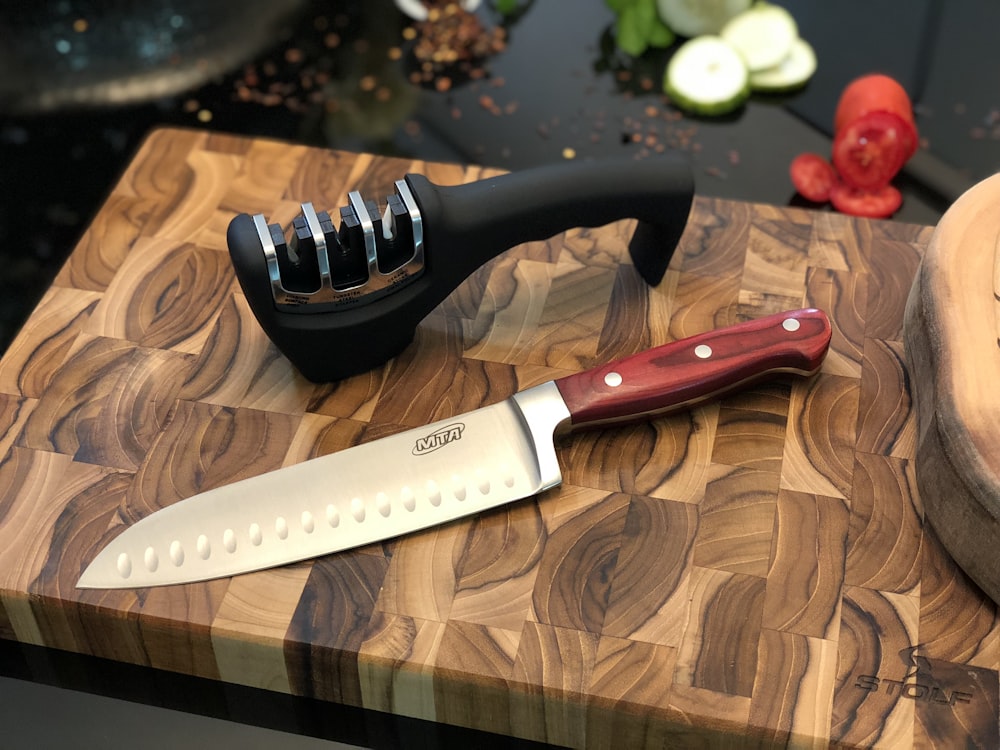Best Knife Sharpeners Reviewed: Keeping Your Blades Razor-Sharp
Best Knife Sharpeners Reviewed
In the culinary world, a sharp knife is as essential as the food itself. It’s not just a tool; it’s an extension of the chef’s hand, ensuring precision, safety, and efficiency in every slice. However, even the highest quality knives can succumb to the dullness brought about by regular use. This is where the importance of knife sharpeners comes into play, transforming dull blades back into their prime condition with ease and efficiency.
There are various types of knife sharpeners available on the market, each designed to suit different preferences and knife maintenance needs. From the swift and straightforward electric sharpeners to the traditional manual types and the artisanal approach using sharpening stones, the options are plentiful. Understanding the nuances of each type can not only enhance the longevity of your knives but also elevate your culinary skills by ensuring your tools are always in their best form.
As we delve into the world of knife sharpeners, we will explore the top models in each category, reviewing their features, benefits, and how they stand out in the culinary toolkit. Whether you’re a professional chef looking for precision or a home cook aiming for convenience, this guide will help you navigate the vast sea of sharpeners, ensuring your blades remain razor-sharp and ready for any culinary challenge that comes your way.
In any kitchen, the sharpness of a knife can dramatically affect both the pleasure of cooking and the quality of the results. A well-maintained, sharp knife ensures precision cuts, safer food preparation, and less physical strain on the cook. The journey to maintaining such efficiency lies in the art and science of knife sharpening—a skill that both professionals and home cooks cherish.

Importance of Keeping Knives Sharp
Sharp knives are not just about efficiency; they are also about safety. A sharp blade is predictable. When cutting, it goes exactly where you intend it to, reducing the risk of slipping and causing an injury. Furthermore, using a sharp knife can help preserve the texture and integrity of the food, ensuring that you get the most out of your ingredients.
Overview of Different Types of Knife Sharpeners
The market offers a wide array of knife sharpeners, each catering to different needs and skill levels. Here’s a brief overview:
- Electric Knife Sharpeners: These are the epitome of convenience and efficiency. Designed for those who value time and precision, electric sharpeners can quickly restore a blade’s edge with minimal effort.
- Manual Knife Sharpeners: For those who prefer a bit more control over the sharpening process, manual sharpeners offer a balance between the traditional and the practical. They are compact, portable, and great for quick touch-ups.
- Sharpening Stones: The choice of purists and professionals, sharpening stones offer the most control and best results. They require more skill and patience but reward with unparalleled sharpness and longevity of the blade’s edge.
Each type of sharpener has its place in the kitchen, and understanding how to use them effectively can transform your culinary experience. As we progress through this guide, we’ll delve deeper into each sharpener type, exploring their pros and cons, and reviewing top models to help you make an informed decision on which sharpener is best suited for your kitchen.
Electric Knife Sharpeners: Effortless Precision
In the pursuit of culinary perfection, the role of electric knife sharpeners cannot be overstated. Designed for efficiency and ease, these devices are the go-to solution for those who demand consistently sharp blades without the time investment required by more traditional methods.
Features and Benefits
Electric knife sharpeners offer a host of features that cater to both novice cooks and seasoned chefs. Most models come equipped with multiple sharpening stages, allowing for coarse grinding, sharpening, and honing of the blade with precise control. This multi-stage process ensures that knives are not only sharpened but also polished, resulting in a blade that glides through ingredients with minimal effort.
The convenience factor of electric sharpeners is a significant advantage. With simple one-touch operations, these devices eliminate the guesswork involved in achieving the perfect edge. Safety features, such as non-slip bases and automatic blade positioning, further enhance the user experience by ensuring stability and accuracy during the sharpening process.
Top Models Reviewed
While there are numerous electric knife sharpeners on the market, a few stand out for their exceptional performance, durability, and user-friendly design:
- Chef’sChoice Trizor XV EdgeSelect: Renowned for transforming any knife into a high-performance Trizor XV edge, this sharpener excels in versatility, working equally well on straight-edge and serrated knives.

- Work Sharp Culinary E5: This model is appreciated for its automated sharpening cycles and built-in vacuum to collect metal filings, making it a clean and efficient choice for any kitchen.

- Presto Professional Electric Knife Sharpener: Offering an affordable yet effective solution, this sharpener is praised for its three-stage sharpening system that delivers precise and quick results.
These electric sharpeners are just a few examples of how modern technology can simplify the task of knife maintenance, ensuring your culinary tools are always ready for action. Whether you’re preparing a feast for a special occasion or simply dicing vegetables for a weeknight dinner, a reliable electric knife sharpener can make all the difference in your cooking experience.
Manual Knife Sharpeners: Control and Tradition
In the hands of a skilled chef, a manual knife sharpener is more than just a tool—it’s a bridge to the past, connecting modern culinary practices with the age-old art of knife maintenance. For many, the appeal of manual sharpeners lies in the control and satisfaction that comes from sharpening knives by hand.
How They Work and Their Advantages
Manual knife sharpeners often feature a simple yet effective design, consisting of one or more slots through which the blade is drawn. These slots are equipped with abrasive materials, such as ceramic or diamond, that sharpen the knife’s edge with each pass. Some models offer adjustable angles, allowing for precise sharpening tailored to the blade’s original geometry.
The advantages of manual sharpeners are manifold. They require no power source, making them portable and convenient for use anywhere, from a bustling kitchen to a remote campsite. The tactile feedback during sharpening allows for a more intimate connection with the tool, enabling users to feel the transformation of the blade’s edge.
Recommended Products
Several manual knife sharpeners stand out for their efficiency, durability, and ease of use:
-
Chef’sChoice 4643 Manual Knife Sharpener: Compact and versatile, this sharpener is ideal for keeping both straight and serrated blades in peak condition.


-
Work Sharp Precision Adjust Knife Sharpener: Offering four different sharpening angles, this tool is perfect for those seeking versatility and precision.
-
Orange Ninja Knife Sharpener: Designed for quick touch-ups, this sharpener features two stages for coarse and fine sharpening, making it a staple in many kitchens.
Manual sharpeners embody the balance between tradition and practicality, offering a hands-on approach to knife maintenance that many chefs and home cooks appreciate. By selecting the right sharpener and mastering its use, you can ensure your knives remain sharp, reliable, and ready for any culinary challenge.
Sharpening Stones: The Art of Precision
At the heart of traditional knife sharpening lies the sharpening stone, a method cherished for its precision and the unparalleled edge it can produce. This method, while requiring more skill and patience, connects the user to the very essence of culinary craftsmanship.
Introduction to Using Sharpening Stones
Sharpening stones, or whetstones, come in a variety of grits, each designed for different stages of the sharpening process. Starting with a coarse grit to reshape the edge, moving to a medium grit for sharpening, and finishing with a fine grit for honing, the process is both an art and a science. Unlike electric or manual sharpeners, sharpening stones offer complete control over the sharpening angle and pressure, allowing for a custom-finished edge tailored to each knife’s specific needs.

Tips for Getting the Best Results
- Soak the Stone: Most stones require soaking in water before use to prevent the metal filings from clogging the stone’s surface.
- Maintain the Angle: Keeping a consistent angle between the knife and the stone is crucial for achieving a sharp edge. A guide or jig can help beginners maintain this angle.
- Use Gentle Pressure: Let the stone do the work. Excessive pressure can lead to uneven sharpening and reduce the stone’s lifespan.
- Keep It Wet: Regularly wetting the stone during sharpening ensures smooth action and prevents overheating of the blade.
- Practice: Mastery of sharpening stones comes with practice. Start with knives that are less critical to develop your technique before moving on to your best blades.
Maintaining Your Sharpening Stone
Just as your knives require care, so do your sharpening stones. Flattening the stone periodically ensures it remains effective, and cleaning it after each use prolongs its life. Embracing the process of using and caring for sharpening stones not only keeps your knives in top condition but also enhances your connection to the culinary arts.
Maintenance and Care for Sharpened Knives
Achieving a razor-sharp edge on your knives is just the beginning. Maintaining that sharpness and ensuring the longevity of both your knives and sharpeners requires regular care and attention. Here are some essential tips to keep your blades in top condition:
- Regular Honing: Between sharpenings, use a honing rod to realign the edge of the knife. This maintains the sharpness for longer and extends the intervals between sharpening sessions.
- Proper Storage: Avoid tossing your knives in a drawer where they can become dull or damaged. Instead, store them on a magnetic strip, in a knife block, or with blade guards to protect the edges.
- Use the Right Cutting Surface: Hard surfaces like glass or stone can dull your knives quickly. Opt for wooden or plastic cutting boards that are gentler on the blades.
- Clean Knives by Hand: Dishwashers can be harsh on knives, leading to premature dulling. Wash knives by hand with warm, soapy water and dry them immediately to prevent rust and corrosion.
- Avoid Misuse: Knives are designed for cutting, not as tools for opening cans or prying. Misuse can damage the blade or handle, reducing the knife’s effectiveness and safety.
Dos and Don’ts After Sharpening
- Do test the sharpness of your knife on a piece of paper or a tomato to ensure it meets your expectations.
- Don’t use a newly sharpened knife on hard foods or materials that could damage the edge.
- Do familiarize yourself with the specific care instructions for your sharpeners and knives, as some materials may require special attention.
- Don’t neglect the importance of professional sharpening for high-quality knives. Even with regular maintenance, a professional touch can maximize performance and longevity.
By following these guidelines, you can enjoy the benefits of sharp, reliable knives that enhance your culinary creations and make cooking a joy. Remember, a well-maintained knife is a chef’s best friend, reflecting the care and passion that goes into every dish.



